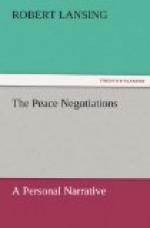It is very apparent to one, who without prejudice reviews the state of public sentiment in December, 1918, that the trouble, which later developed as to a League of Nations, did not lie in the necessity of convincing the peoples of the world, their governments, and their delegates to the Paris Conference that it was desirable to organize the world to prevent future wars, but in deciding upon the form and functions of the organization to be created. As to these details, which of course affected the character, the powers, and the duties of the organization, there had been for years a wide divergence of opinion. Some advocated the use of international force to prevent a nation from warring against another. Some favored coercion by means of general ostracism and non-intercourse. Some believed that the application of legal justice through the medium of international tribunals and commissions was the only practical method of settling disputes which might become causes of war. And some emphasized the importance of a mutual agreement to postpone actual hostilities until there could be an investigation as to the merits of a controversy. There were thus two general classes of powers proposed which were in the one case political and in the other juridical. The cleavage of opinion was along these lines, although it possibly was not recognized by the general public. It was not only shown in the proposed powers, but also in the proposed form of the organization, the one centering on a politico-diplomatic body, and the other on an international judiciary. Naturally the details of any plan proposed would become the subject of discussion and the advisability of adopting the provisions would arouse controversy and dispute. Thus unanimity in approving a world organization did not mean that opinions might not differ radically in working out the fundamental principles of its form and functions, to say nothing of the detailed plan based on these principles.
In May, 1916, President Wilson accepted an invitation to address the first annual meeting of the League to Enforce Peace, which was to be held in Washington. After preparing his address he went over it and erased all reference to the use of physical force in preventing wars. I mention this as indicative of the state of uncertainty in which he was in the spring of 1916 as to the functions and powers of the international organization to maintain peace which he then advocated. By January, 1917, he had become convinced that the use of force was the practical method of checking aggressions. This conversion was probably due to the fact that he had in his own mind worked out, as one of the essential bases of peace, to which he was then giving much thought, a mutual guaranty of territorial integrity and political independence, which had been the chief article of a proposed Pan-American Treaty prepared early in 1915 and to which he referred in his address before the League to Enforce Peace. He appears to have reached the conclusion that a guaranty




